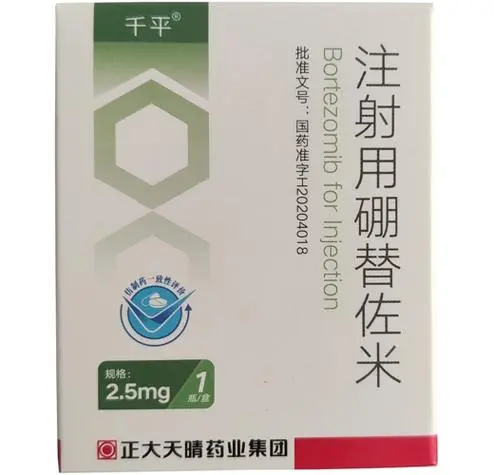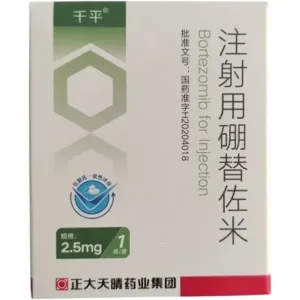Bortezomib for Injection
Effects and efficacy:
Multiple myeloma: combined with melphalan and prednisone (MP regimen) for multiple myeloma that has not been treated before and is not suitable for high-dose chemotherapy and bone marrow transplantation. Or used alone to treat relapsed multiple myeloma that has received at least one previous treatment regimen. Mantle cell lymphoma: combined with cyclophosphamide, rituximab, doxorubicin, and prednisone for mantle cell lymphoma that has not been treated before and is not suitable for hematopoietic stem cell transplantation. Or used to treat relapsed or refractory mantle cell lymphoma that has received at least one previous treatment regimen.
Dosage and administration:
Administered intravenously or subcutaneously, intrathecal injection is contraindicated, and intrathecal injection can cause death. For the treatment of mantle cell lymphoma, conventional doses for adults, intravenous injection. Patients who have received previous treatment: 1.3 mg/m2 once, twice a week, 2 weeks of continuous use, then stop for 10 days, 3 weeks as a course of treatment (i.e., administration on days 1, 4, 8, and 11, and stop on days 12-21). For maintenance treatment of more than 8 courses, the drug can be administered according to the standard regimen. For patients who have not received treatment before: combined with cyclophosphamide, rituximab, doxorubicin and prednisone, the platelet count should be greater than or equal to 100×109/L before each course (except the first course), the absolute neutrophil count (ANC) should be greater than or equal to 1.5×109/L, the hemoglobin should be greater than or equal to 8g/dl, and non-hematological toxicity should be alleviated to grade 1 or the level before medication. This drug is 1.3mg/m2 once, twice a week, and the drug is stopped for 10 days after 2 weeks of continuous use. A course of treatment is 3 weeks (i.e., the drug is administered on the 1st, 4th, 8th and 11th days, and the drug is stopped on the 12th to 21st days), and 6 courses of treatment are used in succession (if the first reaction occurs in the 6th course, it is recommended to give an additional 2 courses). Cyclophosphamide (750 mg/m2 once), rituximab (375 mg/m2 once), and doxorubicin (50 mg/m2 once) are given intravenously on the first day of the drug administration; prednisone (100 mg/m2 once) is given orally on the first, second, third, fourth, and fifth days of the drug administration. For the treatment of multiple myeloma in adults, conventional doses are given intravenously in patients who have previously received treatment: ① 1.3 mg/m2 once, twice a week, for 2 consecutive weeks, then stop for 10 days, 3 weeks as a course of treatment (i.e., give the drug on the 1st, 4th, 8th, and 11th days, and stop the drug on the 12th to 21st days). ② For maintenance treatment of more than 8 courses of treatment, the drug can be given according to the standard regimen; it can also be given once a week, for 4 consecutive weeks, then stop the drug for 13 days (i.e., give the drug on the 1st, 8th, 15th, and 22nd days, and stop the drug on the 23rd to 35th days). Patients who have not received treatment before: Before any course of treatment with melphalan and prednisone, the platelet count should be greater than or equal to 70×109/L, the ANC should be greater than or equal to 1.0×109/L, and non-hematological toxicity should be alleviated to grade 1 or the level before medication. This drug is 1.3 mg/m2 once, and one course of treatment is 6 weeks, for a total of 9 courses. The 1st to 4th courses are given twice a week (i.e., on the 1st, 4th, 8th, 11th, 22nd, 25th, 29th and 32nd days, and the drug is stopped on the 3rd and 6th weeks); the 5th to 9th courses are given once a week (i.e., on the 1st, 8th, 22nd and 29th days, and the drug is stopped on the 3rd and 6th weeks). Melphalan (9 mg/m2 once) and prednisone (60 mg/m2 once) are given orally on the 1st, 2nd, 3rd and 4th days of each course. No dose adjustment is required for patients with renal impairment. Dosage for hepatic impairment: No dose adjustment is required for patients with mild hepatic impairment (bilirubin level ≤ upper limit of normal (ULN) and aspartate aminotransferase (AST) > ULN; or 1 times ULN < bilirubin level ≤ 1.5 times ULN and AST is any value). For patients with moderate (1.5 times ULN < bilirubin level ≤ 3 times ULN and AST is any value) and severe (bilirubin level > 3 times ULN and AST is any value) hepatic impairment, the dose is reduced to 0.7 mg/m2 once in the first course of treatment. Depending on tolerance, the dose is subsequently increased to 1.0 mg/m2 or further reduced to 0.5 mg/m2. Dose during dialysis: Since dialysis can reduce the concentration of this drug, this drug should be administered after the end of dialysis. Dose during toxicity: If grade 3 non-hematological toxicity (except neuropathy) or any grade 4 hematological toxicity occurs, the drug should be suspended. Once the toxicity symptoms are relieved, the drug can be restarted, but the dose should be reduced by 25% (i.e., from 1.3 mg/m2 to 1 mg/m2, or from 1 mg/m2 to 0.7 mg/m2). If grade 1 peripheral neuropathy (asymptomatic; paresthesia or loss of deep tendon reflexes) occurs without pain or loss of function, no dose adjustment is required; if grade 1 peripheral neuropathy with pain or grade 2 peripheral neuropathy (moderate symptoms; limited instrumental daily activities) occurs, the dose of this drug should be reduced to 1 mg/m2 or the treatment regimen of this drug should be changed to 1.3 mg/m2 once a week; if grade 2 peripheral neuropathy with pain or grade 3 peripheral neuropathy (severe symptoms; limited self-care daily activities) occurs, the drug should be suspended until the toxicity symptoms are relieved and then resumed, but the dose should be reduced to 0.7 mg/m2 once a week; if grade 4 peripheral neuropathy (life-threatening; indications for emergency intervention) occurs, the drug should be discontinued. When used in combination with cyclophosphamide, rituximab, doxorubicin, and prednisone, if grade 3 or higher ANC decrease with fever, grade 4 ANC decrease lasting more than 7 days, or platelet count less than 10×109/L occurs, the drug should be suspended until the ANC is greater than or equal to 0.75×109/L and the platelet count is greater than or equal to 25×109/L. If the toxicity is not relieved after 2 weeks of suspension, the drug should be discontinued; if the ANC is greater than or equal to 0.75×109/L and the platelet count is greater than or equal to 25×109/L within 2 weeks of suspension, the drug should be restarted at a reduced dose level (i.e., from 1.3mg/m2 to 1mg/m2, or from 1mg/m2 to 0.7mg/m2). If the ANC is less than 0.75×109/L or the platelet count is less than 25×109/L on the day of administration of this drug (except the first day), the drug should be suspended. If non-hematological toxicity of grade 3 or above occurs, the drug should be suspended until the toxic symptoms are relieved to grade 2 or below, and the drug can be restarted at a reduced dose level (i.e., from 1.3 mg/m2 to 1 mg/m2, or from 1 mg/m2 to 0.7 mg/m2). For dose adjustments for neuropathic pain and/or peripheral neuropathy associated with this drug, see “Dose adjustments in toxic states when using this drug alone.” If persistent grade 4 neutropenia or thrombocytopenia, or thrombocytopenia with bleeding occurs in the previous course of treatment when used in combination with melphalan and prednisone, consideration should be given to reducing the melphalan dose by 25% in the next course of treatment; if the platelet count on the day of administration of this drug (except day 1) is less than or equal to 30×109/L or the ANC is less than or equal to 0.75×109/L, this drug should be discontinued; if this drug is discontinued several times in one course of treatment (≥3 times during twice-weekly dosing, or ≥2 times during once-weekly dosing), the dose level should be reduced by one level in the next course of treatment (from 1.3 mg/m2 to 1 mg/m2, or from 1 mg/m2 to 0.7 mg/m2). If non-hematological toxicity of grade 3 or above occurs, the drug should be suspended until the toxic symptoms are relieved to grade 1 or the pre-drug level, and then the drug should be resumed to reduce the dose level and restart the drug (from 1.3mg/m2 to 1mg/m2, or from 1mg/m2 to 0.7mg/m2). For dose adjustments for neuropathic pain and/or peripheral neuropathy associated with this drug, see “Dose adjustments when using this drug alone in a toxic state”.
Drug contraindications:
Contraindicated if allergic to this product
Related dosage forms:
Bortezomib for injection
Share:
Products
Our offers
Health Classification
Let us work together to protect precious health





























